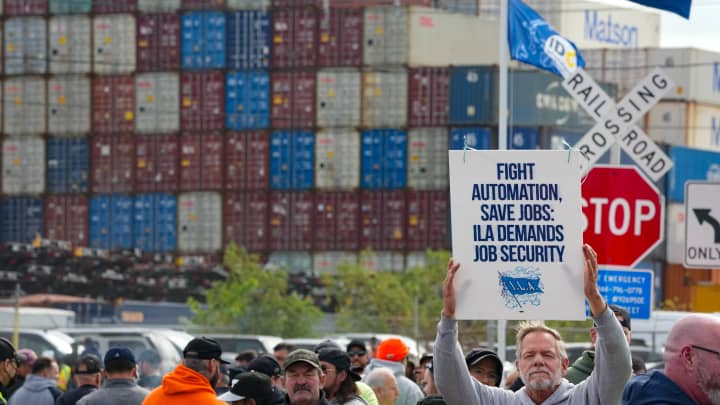New York – In a significant breakthrough for the U.S. shipping industry, striking members of the International Longshoremen’s Association (ILA) are set to resume work on Friday after reaching a tentative agreement with their employers. The agreement, which includes a substantial wage hike, brings hope for an end to a labor dispute that had begun to impact the country’s critical port infrastructure and disrupt supply chains.
The ILA, which represents over 50,000 dockworkers from Maine to Texas, has been on strike since Tuesday morning. The walkout halted the operations of major U.S. ports, leaving dozens of ships stranded offshore and delaying the flow of goods, including essential imports and exports. Now, both the ILA and the United States Maritime Alliance (USMX), which represents shipping companies, terminal operators, and port authorities, have announced an accord that could ease these disruptions.
At the heart of the deal is a wage increase of $4 per hour each year for the next six years. This would result in a cumulative pay raise of 62% over the life of the contract, with the first year’s increase exceeding 10% of the current top hourly wage of $39. Union sources said the tentative agreement would bring an immediate sense of relief to workers who had been on the front lines of the pandemic, keeping the ports operational under challenging circumstances.
The existing contract, which expired earlier this week, has now been extended until January 15, 2025. This extension allows time for both sides to finalize the remaining details and present the full agreement for a ratification vote by union members. Union leaders have expressed cautious optimism that this deal could win broad support among the rank-and-file, though they acknowledged that the final outcome depends on the vote.
A Key Role for the Biden Administration
President Joe Biden was quick to praise the tentative deal, applauding the hard work of both the ILA and the USMX in coming together to reach an agreement. In a statement, Biden highlighted the importance of this contract not only for the dockworkers but also for the U.S. economy as a whole.
“Today’s tentative agreement on record-setting wages marks an important step toward securing a strong contract that reflects the sacrifices made by our dockworkers during the pandemic. I congratulate the ILA members for their resilience, and I commend the US Maritime Alliance for presenting a fair offer,” Biden said.
Labor Secretary Julie Su was closely involved in the negotiations, meeting with both parties in North Bergen, New Jersey, as talks progressed. Su, who had also been instrumental in resolving a labor dispute involving West Coast dockworkers in 2023, was praised for her role in guiding the two sides toward compromise.
The Biden administration had previously refused calls to invoke the Taft-Hartley Act to end the strike, instead urging both parties to continue negotiations. This approach contrasted with some business groups that had pushed for more aggressive intervention, citing the potential economic fallout from prolonged port closures.
The Broader Economic Impact
The strike came at a time when U.S. retailers were preparing for the busy holiday season. Business groups had expressed growing concern that the walkout could lead to shortages of essential goods, from fresh produce to consumer electronics, with ripple effects likely to be felt across the entire supply chain. These shortages, in turn, could have placed upward pressure on prices, just as inflation remains a major concern for the broader economy.
For several days, U.S. ports became chokepoints, with ships left idling offshore, unable to unload their cargo. Imports of key goods, such as bananas, coffee, and European automobiles, were delayed, while American exports also suffered. As companies scrambled to find alternative solutions, the economic costs of the strike began to accumulate.
Many industry analysts had warned that a prolonged strike could have severe consequences for U.S. businesses that depend on uninterrupted access to global markets. With the strike now potentially nearing resolution, there is hope that normal port operations will soon resume, restoring the critical flow of goods.
A Fragile Deal
However, the tentative agreement remains just that—tentative. While the leadership of both the ILA and USMX have signaled their support for the deal, the union’s rank-and-file members will have the final say. Should they vote to reject the contract, the strike could resume, potentially plunging the country’s ports back into a state of paralysis.
The ILA’s internal dynamics have seen similar instances of deals being rejected by members. Just last month, the International Association of Machinists (IAM) saw its members vote down a tentative agreement with Boeing, despite leadership recommending its approval. The machinists have remained on strike since mid-September, further illustrating the volatility of labor negotiations in today’s economic climate.
Shipping companies, which have enjoyed record profits in recent years, particularly during the pandemic, had offered workers a 50% pay increase over six years. However, ILA leadership, led by President Harold Daggett, initially pushed for an even larger wage increase of $5 per hour annually, which would have raised wages by 77% over the life of the contract. The eventual compromise of $4 per hour represents a significant concession by both sides.
Looking Ahead
As the two sides move toward finalizing the agreement, attention will now turn to the vote. For the ILA’s membership, the decision will likely hinge on whether the proposed wage increases meet their expectations for fair compensation. If ratified, the new contract could bring a period of stability to the U.S. shipping industry, which has been battered by disruptions in recent years.
For now, the resumption of work at the ports provides a welcome reprieve for businesses, consumers, and workers alike. However, until the agreement is officially ratified, uncertainty remains. The coming days will be critical in determining whether the tentative deal represents the end of this labor dispute or merely a pause before further conflict.









